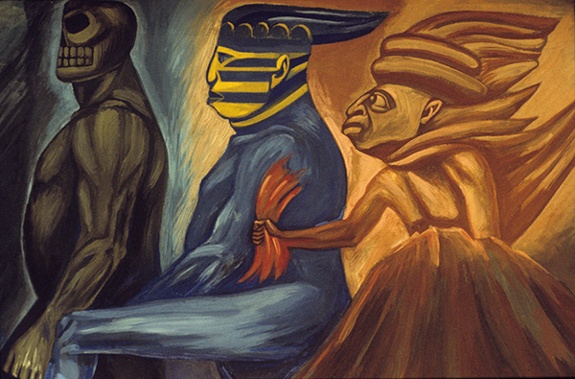Hispanic Heritage Month: José Clemente Orozco
In a recent conversation with another artist, the subject of immigration came up. She reminded me that the term “we are all immigrants,” when used in countries in the Western Hemisphere, is perfectly appropriate going all the way back to the migration of people from Asia into the Americas 30,000 to 15,000 years ago. Those peoples populated the Americas over the next 10,000 years, long before Europeans ever set foot in the Americas. That migration resulted in the development of some of the most fabulous urban cultures ever seen in the world, including those in Mexico. Looking at José Clemente Orozco’s mural from Dartmouth College is a perfect way to celebrate the history of Mexico’s early civilizations.
 |
| José Clemente Orozco (1883–1949, Mexico), The Coming of Quetzalcoatl (Panel 5), from The Coming and Departure of Quetzalcoatl, west wing of The Epic of American Civilization mural cycle, 1932–1934. Fresco, 10'5" x 17' (318.8 x 520.7 cm). Hood Museum of Art, Baker Library, Dartmouth College, Hanover, New Hampshire. Original photo: John Rosenthal/Rosenthal Art Slides/Davis Art Images. Art © 2024 José Clemente Orozco/Artists Rights Society (ARS), New York. (8S-19620orars) |
Orozco's first mural in the United States, Prometheus, was painted in 1930 at the Benton Museum of Art at Pomona College in Claremont, California. He then painted murals for the New School for Social Research in New York from 1930 to 1931. After that, he eagerly accepted a commission at Dartmouth College for a "New World epic," originally planned as another classically based composition. Once he saw the size of the space allotted for the murals, he abandoned his Greek mythology idea for mythology that was more specific to the Americas.
In panel 5 of Orozco's The Epic of American Civilization mural cycle, the ancient Mexican feathered serpent god, Quetzalcoatl, appears in human form. He blesses humanity with learning, culture, and the arts. At the same time, he dispels the previous pantheon of gods, as seen in the upper right. Quetzalcoatl inspires humanity as it is awakening from a deep sleep below him. They perform great feats of creation, symbolized by the Temples of the Sun and the Moon from the ancient Mexican metropolis state of Teotihuacán in the middle ground. The people conversing in the lower right symbolize the beginning of communal living, the basis of all societies.
From colonial times through the late 1800s, Mexican art was dominated by the influence of art from Europe. Through the 1700s, that influence was mostly from Spanish Baroque and Rococo painting, sculpture, and architecture. During the 1800s, many Mexican artists traveled to Europe to study in both Spanish academies and in Paris, which was the art center of Western Europe at the time.
Starting in the 1880s, a major art genre evolved in the form of satirical prints that criticized ills in Mexican society and willingness of the common people to go along with them. After the Mexican Revolution of 1910–1920, Social Realism—a style that documented genre scenes and the circumstances of the common person—replaced academic styles that were dominated by history painting and portraiture.
Orozco's art was shaped by the savagery of the Revolution, which had degenerated into a civil war for almost a decade. In a sentiment that evolved before the Russian Revolution in 1917, He came to the conclusion that concepts of race, nationality, politics, and religion shackled human beings to authoritarian dogmas and prevented genuine harmony of society and personal expression. Orozco was as fervent an optimist about the lot of humanity as he was a pessimist.
Born of poor parents in Jalisco, Orozco originally studied in Mexico City to become an agronomist and then an architect. An accident with fireworks in 1904 caused him to lose his left hand and reoriented his ambition from architect to artist. Already in the 1890s, seeing the workshop of the satirical printmaker Jose Guadalupe Posada (1852–1913) motivated Orozco to study art at the Academy of San Carlos (National Academy of Fine Arts) in Mexico City. Printmaking would be the art form that gained Orozco national attention in the United States when he was there from 1927 to 1934.
From 1906 to 1914, Orozco studied painting at the Academy of San Carlos. It was there that he studied Italian Renaissance frescoes and came to understand the didactic and artistic implication of wall painting. Between 1910 and 1917, he worked on a number of mural projects and also became involved in illustrating revolutionary literature. During his first visit to the United States from 1917 to 1919, Orozco worked primarily as a sign painter in California and New York.
After returning from the United States, Orozco continued to paint murals in public buildings and illustrate revolutionary literature. Orozco’s murals dealt with revolutionary subjects and generally the welfare of the poor and working classes. In 1927, he began an extended visit to the United States, during which he painted many mural programs, including the important cycle, The Epic of American Civilization, at Dartmoth College.
 |
| José Clemente Orozco, The Coming of Quetzalcoatl (Panel 5), detail: the gods dispelled by Quetzalcoatl (left to right): Mictlantecuhtli (god of death), Huitzilopochtli (god of war), and Huehueteotl (god of fire), from The Coming and Departure of Quetzalcoatl, west wing of The Epic of American Civilization mural cycle, 1932–1934. Hood Museum of Art, Baker Library, Dartmouth College, Hanover, New Hampshire. Original photo: John Rosenthal/Rosenthal Art Slides/Davis Art Images. Art © 2024 José Clemente Orozco/Artists Rights Society (ARS), New York. (8S-19621orars) |
Correlations to Davis programs: Explorations in Art 2E Grade 6: 3.4; Experience Art: 3.2 p. 124ff, 7.1 p. 284ff; A Personal Journey 2E: 4.4; A Community Connection 2E: 8.4 pp. 228-229; A Global Pursuit 2E: 3.1 p. 66; The Visual Experience 4E: 8.3 p. 296; 11.9; Experience Painting: chapter 8

Comments